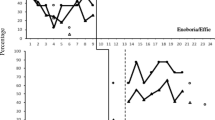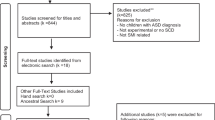Abstract
Sibling conflict can rise to the level of a clinical problem. In Phase 1 a lengthy behavioral role-play analog sampling child reactions to normal sibling conflicts was successfully shortened. In Phase 2 normal children who lacked sibling conflict resolution skills were randomly assigned to a Training or Measurement Only condition. Training consisted of five clinic sessions focusing on verbal reasoning, assertiveness, and acceptance skills. Trained children outperformed Measurement Only children on the shortened role-play test. Parents of trained children, but not untrained children, perceived improved social competence in the home. The project provides an empirical foundation for future research with aggressive siblings.
Similar content being viewed by others
References
Achenbach, T. M., & Rescorla, L. A. (2000). Manual for the ASEBA school-age forms & profiles. Burlington, VT: University of Vermont.
Allison, T. S., & Allison, S. L. (1971). Timeout from reinforcement: Effect on sibling aggression. The Psychological Record, 21, 81–86.
Arnold, S. B. (1990). Creation and validation of an instrument for the assessment of sibling social skills. Unpublished master’s thesis, Idaho State University, Pocatello, ID.
Boer, F., & Dunn, J. (1992). Children’s sibling relationships: Developmental and ethical issues. Hillsdale, NJ: Erlbaum.
Brody, G. H., Stoneman, Z., & MacKinnon, C. E. (1986). Contributions of maternal child-rearing practices and play contexts to sibling interactions. Journal of Applied Developmental Psychology, 7, 235–236. doi:10.1016/0193-3973(86)90031-6.
Carter, A. S., & Volkman, F. R. (1992). Sibling rivalry: Diagnostic category or focus of treatment? In B. B. Lahey & A. E. Kazdin (Eds.), Advances in clinical child psychology (Vol. 14, pp. 289–295). New York: Plenum.
Dunn, J. (1983). Sibling relationships in early childhood. Child Development, 54, 787–811. doi:10.2307/1129886.
Dunn, J. (1988). Sibling influences on childhood development. Journal of Child Psychology and Psychiatry and Allied Disciplines, 29, 119–127. doi:10.1111/j.1469-7610.1988.tb00697.x.
Dunn, J., & Munn, P. (1987). Development of justification in disputes with mother and sibling. Developmental Psychology, 23, 791–798. doi:10.1037/0012-1649.23.6.791.
Dunn, J., Stocker, C., & Plomin, R. (1990). Assessing the relationship between young siblings: A research note. Journal of Child Psychology and Psychiatry and Allied Disciplines, 31, 983–991. doi:10.1111/j.1469-7610.1990.tb00839.x.
Hawkins, R. P., Peterson, R. F., Schweid, E., & Bijou, S. W. (1966). Behavior therapy in the home: Amelioration of problem parent-child relations with the parent in a therapeutic role. Journal of Experimental Child Psychology, 4, 99–107. doi:10.1016/0022-0965(66)90054-3.
Jones, R. N., Sloane, H. N., & Roberts, M. W. (1992). Limitations of “don’t” instructional control. Behavior Therapy, 23, 131–140. doi:10.1016/S0005-7894(05)80313-2.
Kramer, L., & Bank, L. (2005). Sibling relationship contributions to individual and family well-being: Introduction to the special issue. Journal of Family Psychology, 19, 483–485. doi:10.1037/0893-3200.19.4.483.
Kramer, L., & Radey, C. (1997). Improving sibling relationships among young children: A social skills training model. Family Relations, 46, 237–246. doi:10.2307/585121.
Lund, J., & Merrell, K. W. (2001). Social and antisocial behavior of children with learning and behavioral disorder: Construct validity of the Home and community Social Behavior Scales. Journal of Psychoeducational Assessment, 19, 112–122. doi:10.1177/073428290101900201.
Myers, J. D., & Bean, L. L. (1968). A decade later: A follow-up of social class and mental illness. New York: Wiley.
O’Leary, K. D., O’Leary, S., & Becker, W. C. (1967). Modification of a deviant sibling interaction pattern in the home. Behaviour Research and Therapy, 5, 113–120. doi:10.1016/0005-7967(67)90005-8.
Olson, R. L., & Roberts, M. W. (1987). Alternative treatments for sibling aggression. Behavior Therapy, 18, 243–250. doi:10.1016/S0005-7894(87)80018-7.
Patterson, G. R. (1984). Siblings: Fellow travelers in coercive family processes. In R. J. Blanchard & D. C. Blanchard (Eds.), Advances in the study of aggression (Vol. 1, pp. 173–215). New York: Academic Press.
Patterson, G. R. (1986). The contribution of siblings to training for fighting: A microsocial analysis. In D. Olweus, J. Block, & M. Radke-Yarrow (Eds.), Development of antisocial and prosocial behavior (pp. 235–261). New York: Academic Press.
Putallaz, M., & Gottman, J. (1983). Social relationship problems in children: An approach to intervention. In B. B. Lahey & A. E. Kazdin (Eds.), Advances in clinical child psychology (Vol. 6, pp. 1–43). New York: Plenum Press.
Roberts, M. W., Arnold, S. B., & Mangum, P. F. (1992). The sibling conflict resolution scale. The Behavior Therapist, 15, 254–255.
Schroeder, C. S., & Gordon, B. N. (1991). Assessment and treatment of childhood problems: A clinician’s guide. New York: Guilford.
Thomas, B. (2002). Sex differences in sibling conflict and sibling conflict resolution skills. Unpublished master’s thesis, Idaho State University, Pocatello, ID.
Thomas, B., Roberts, M., Guajardo, N., & Jamison, H. (2002, November). The sibling conflict resolution scale. Poster session presented at the annual meeting of the Association for the Advancement of Behavior Therapy, Reno, NV.
Thomas, B. W., & Roberts, M. W. (2006, November). Training siblings to resolve conflicts. Poster session presented at the annual meeting of the Association for Behavioral and Cognitive Therapies, Chicago.
Acknowledgements
Part of these data were originally presented as posters at the 2002 annual meeting of the Association for the Advancement of Behavior Therapy, Reno NV (Thomas et al. 2002) and the 2006 annual meeting of the Association of Behavior and Cognitive Therapy, Chicago (Thomas and Roberts 2006). A copy of the SCRS III manual that includes all procedural details is available for the cost of reproduction from the senior author upon request (Mark Roberts, Ph.D., Psychology Department, Stop 8112, 921 South 8th Ave., Idaho State University, Pocatello, ID 83209-8112).
Author information
Authors and Affiliations
Corresponding author
Rights and permissions
About this article
Cite this article
Thomas, B.W., Roberts, M.W. Sibling Conflict Resolution Skills: Assessment and Training. J Child Fam Stud 18, 447–453 (2009). https://doi.org/10.1007/s10826-008-9248-4
Received:
Accepted:
Published:
Issue Date:
DOI: https://doi.org/10.1007/s10826-008-9248-4




